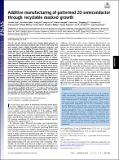| dc.contributor.author | Guo, Yunfan | |
| dc.contributor.author | Su, Cong | |
| dc.contributor.author | Shen, Pin-Chun | |
| dc.contributor.author | Lu, An | |
| dc.contributor.author | Hempel, Marek | |
| dc.contributor.author | Han, Yimo | |
| dc.contributor.author | Ji, Qingqing | |
| dc.contributor.author | Lin, Yuxuan | |
| dc.contributor.author | Shi, Enzheng | |
| dc.contributor.author | McVay, Elaine D. | |
| dc.contributor.author | Dou, Letian | |
| dc.contributor.author | Muller, David A. | |
| dc.contributor.author | Palacios, Tomas | |
| dc.contributor.author | Li, Ju | |
| dc.contributor.author | Ling, Xi | |
| dc.contributor.author | Kong, Jing | |
| dc.date.accessioned | 2019-07-05T15:05:37Z | |
| dc.date.available | 2019-07-05T15:05:37Z | |
| dc.date.issued | 2019-02-12 | |
| dc.date.submitted | 2018-09 | |
| dc.identifier.issn | 0027-8424 | |
| dc.identifier.issn | 1091-6490 | |
| dc.identifier.uri | https://hdl.handle.net/1721.1/121495 | |
| dc.description.abstract | The 2D van der Waals crystals have shown great promise as potential future electronic materials due to their atomically thin and smooth nature, highly tailorable electronic structure, and mass production compatibility through chemical synthesis. Electronic devices, such as field effect transistors (FETs), from these materials require patterning and fabrication into desired structures. Specifically, the scale up and future development of “2D”-based electronics will inevitably require large numbers of fabrication steps in the patterning of 2D semiconductors, such as transition metal dichalcogenides (TMDs). This is currently carried out via multiple steps of lithography, etching, and transfer. As 2D devices become more complex (e.g., numerous 2D materials, more layers, specific shapes, etc.), the patterning steps can become economically costly and time consuming. Here, we developed a method to directly synthesize a 2D semiconductor, monolayer molybdenum disulfide (MoS₂), in arbitrary patterns on insulating SiO₂/Si via seed-promoted chemical vapor deposition (CVD) and substrate engineering. This method shows the potential of using the prepatterned substrates as a master template for the repeated growth of monolayer MoS₂ patterns. Our technique currently produces arbitrary monolayer MoS₂ patterns at a spatial resolution of 2 μm with excellent homogeneity and transistor performance (room temperature electron mobility of 30 cm²V⁻¹s⁻¹ and on–off current ratio of 10⁷. Extending this patterning method to other 2D materials can provide a facile method for the repeatable direct synthesis of 2D materials for future electronics and optoelectronics. Keywords: 2D semiconductor; monolayer MoS₂; patterned growth; growth mechanism; recyclable; masked growth | en_US |
| dc.description.sponsorship | Air Force Office of Scientific Research (Grant FA9550-15-1-0514) | en_US |
| dc.description.sponsorship | National Science Foundation (U.S.) (Grant 0939514) | en_US |
| dc.description.sponsorship | National Science Foundation (U.S.) (Grant DMR-1231319) | en_US |
| dc.language.iso | en | |
| dc.publisher | National Academy of Sciences (U.S.) | en_US |
| dc.relation.isversionof | http://dx.doi.org/10.1073/pnas.1816197116 | en_US |
| dc.rights | Article is made available in accordance with the publisher's policy and may be subject to US copyright law. Please refer to the publisher's site for terms of use. | en_US |
| dc.source | PNAS | en_US |
| dc.title | Additive manufacturing of patterned 2D semiconductor through recyclable masked growth | en_US |
| dc.type | Article | en_US |
| dc.identifier.citation | Guo, Yunfan et al. "Additive manufacturing of patterned 2D semiconductor through recyclable masked growth." Proceedings of the National Academy of Sciences 116, 9 (February 2019): 3437-3442 © 2019 National Academy of Sciences | en_US |
| dc.contributor.department | Massachusetts Institute of Technology. Department of Electrical Engineering and Computer Science | en_US |
| dc.contributor.department | Massachusetts Institute of Technology. Department of Nuclear Science and Engineering | en_US |
| dc.contributor.department | Massachusetts Institute of Technology. Department of Materials Science and Engineering | en_US |
| dc.contributor.department | Massachusetts Institute of Technology. Research Laboratory of Electronics | en_US |
| dc.relation.journal | Proceedings of the National Academy of Sciences | en_US |
| dc.eprint.version | Final published version | en_US |
| dc.type.uri | http://purl.org/eprint/type/JournalArticle | en_US |
| eprint.status | http://purl.org/eprint/status/PeerReviewed | en_US |
| dc.date.updated | 2019-06-27T12:27:29Z | |
| dspace.date.submission | 2019-06-27T12:27:34Z | |
| mit.journal.volume | 116 | en_US |
| mit.journal.issue | 9 | en_US |
